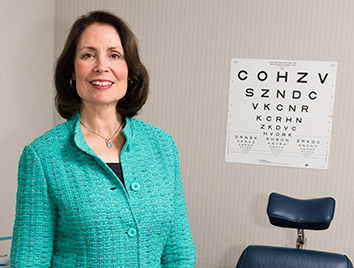Subscriber Benefit
As a subscriber you can listen to articles at work, in the car, or while you work out. Subscribe Now
 WINNER: Advancements in Health Care
WINNER: Advancements in Health Care
Cornea Research Foundation of America
The very first successful corneal transplant happened in 1905. Scissors were used to cut out the existing cornea, which might explain why the procedure didn’t become common until the middle of the century. Materials and techniques had improved significantly by then.
But corneal transplant was still a difficult road, fraught with rejection risk and the potential for adverse side effects, until the Cornea Research Foundation of America and Dr. Francis Price helped pioneer an advancement in corneal transplants that has drawn more than 1,700 patients here for the surgery since 2008.
The surgery was first done in the Netherlands in 2006, but the Cornea Research Foundation has advanced the technique. A striking 44 percent of the patients who have the surgery done in Indianapolis come from other states or other countries. And the foundation conducts training courses for other doctors six times a year, so that its cutting-edge techniques can be used elsewhere.
 Marianne Price, executive director (IBJ photo/Eric Learned)
Marianne Price, executive director (IBJ photo/Eric Learned)“Those who come from out of state come because they’ve done their research and realize the ground-breaking work that we are doing,” said Marianne Price, who is executive director of the foundation and is married to Dr. Price. “We always get a chuckle when patients from the East and West coasts express surprise that the leading cornea transplant center in the world is located in Indiana.”
The Cornea Research Foundation, for its efforts to make the surgery available and to train doctors elsewhere how to perform it, is the 2015 winner of the Health Care Heroes award in the Advancements in Health Care category.
The cornea, which acts as the windshield of the eye, is a clear membrane about the thickness of a credit card. In a traditional cornea transplant, the entire cornea is removed using a cookie-cutter-like device and replaced with donor tissue that is held in place with about 16 sutures. The entire thickness of the cornea is replaced even though the vision problems that lead to transplant are typically caused by a single cell layer lining the back of the cornea.
The new transplant procedure, known as descemet membrane endothelial keratoplasty, or DMEK, replaces only the diseased cell layer. Patients retain about 95 percent of their cornea. The donor tissue is held in place not with sutures but with an air bubble, substantially reducing the risk of complications such as infection.
Manipulating the thin layer of donor cells is among the biggest challenges for the surgeon. The foundation has pioneered new methods for handling the material and has also developed a way to do the procedure with a smaller incision, which reduces recovery time, Price said.
Recovery from a standard transplant can take a year or more, but DMEK patients can often resume normal activities within two weeks, Price said. And follow-up studies of patients who’ve had the procedure done in Indianapolis show that graft rejection has been driven down from 20 percent to 1 percent, she said.
Corneal transplant patients use eye drops to reduce the risk of rejection. With standard transplants, medicating with eye drops can go on for years, causing one in three people to have elevated eye pressure, which can lead to glaucoma.
Price said some doctors who are performing the DMEK transplant continue to prescribe the standard eye drops. But the foundation’s studies show that patients can successfully use lower-strength drops and discontinue their use after a year, further reducing the risk of adverse side effects.
Price said patients who’ve had the transplant often contact Dr. Price—and the others in his Price Vision Group who are trained in the procedure—to express their gratitude.
“They are amazed at how well they can see afterwards and thank us for quite literally giving them their lives back. Often, they had given up driving and other favorite activities before having the transplant,” she said.
They also express their gratitude by donating to the foundation, which is now 26 years old and funded by donations, the income earned from participating in studies sponsored by pharmaceutical and device companies, and the fees charged to surgeons who come here to take the foundation’s courses. Last year, about 40 percent of the foundation’s almost $720,000 budget came from donations.
Robert Grimm, a professor at the Indiana University Kelley School of Business at IUPUI, is on the board of the foundation, but his introduction to Dr. Price and corneal research happened in 2003 when he was diagnosed with Fuch’s Dystrophy, a genetic disorder of the cornea that is one of the leading reasons for corneal transplants.
Grimm received transplants using a procedure that was a precursor to DMEK, but he said it’s likely he’ll need transplants in the future, and he knows he’ll be in good hands with Dr. Price.
“I’d be legally blind today if not for his intervention. I had no appreciation of the expertise in Indianapolis that is world renowned until I had the problem.”•
Please enable JavaScript to view this content.

